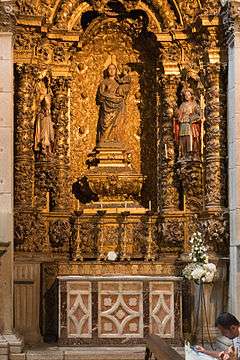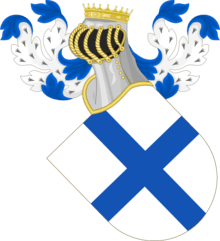Mafalda of Portugal
| Blessed Mafalda | |
|---|---|
|
Queen consort of Castile Lady of Arouca | |
.png) | |
| Queen consort of Castile | |
| Tenure | 1215–1216 |
| Born |
c. 1195 Kingdom of Portugal |
| Died |
1 May 1256 (aged 61) Rio Tinto, Gondomar, Kingdom of Portugal |
| Burial | Arouca Convent, Portugal |
| Spouse | Henry I of Castile |
| House | House of Burgundy |
| Father | Sancho I |
| Mother | Dulce of Aragon |
| Religion | Roman Catholicism |
Infanta Mafalda of Portugal (c. 1195 – Rio Tinto, Gondomar, May 1, 1256; Portuguese pronunciation: [mɐˈfaɫdɐ]) was a Portuguese infanta (princess), later Queen consort of Castile for a brief period. She was the second youngest daughter of King Sancho I of Portugal and Dulce of Aragon. Married briefly to the ten-year-old Henry I of Castile, she held for a time the title Queen of Castile. Upon the dissolution of the marriage, she retired to religious life.
Life
Inheritance
Malfada of Portugal was born around 1195, the daughter of King Sancho I of Portugal and his queen, Dulce of Aragon.
On the death of her father, Mafalda, under the provisions of his will, was to receive the Seia Castle and the remaining portion of the municipality as well as all income produced there. Furthermore, she was granted the right to use the title of queen. This created a conflict with her brother Afonso II O Gordo, who, wanting a centralized power, hindered his sister from receiving the titles and the corresponding rights. Afonso feared that something similar could happen with his two sisters, Teresa and Sancha, and their eventual heirs, creating a problem of sovereignty that could come to divide the country. Much of the Portuguese nobles sided with Mafalda and her sisters, but they were defeated.[1] On the death of Afonso II, his son Sancho II granted some lands and castles to his aunts but he made them renounce the title of princess-queen. The final peace came in 1223.

Marriage
In 1215, a political marriage was arranged between Mafalda and her young cousin Henry I of Castile. As he was about ten years old, the marriage was never consummated, and it was dissolved the following year on grounds of consanguinity.[2] She returned to Portugal.
Religious life
Mafalda then entered the Abbey of Arouca, which had adopted the Cistercian observance, but was granted a special dispensation to retain control of her inheritance. She had a great devotion to Our Lady of Silva and made substantial donations to the shrine in Oporto. she also had a hospice for travelers built as well as a number of bridges, churches, monasteries, and hospitals.[3]
Returning from a pilgrimage to the shrine of Our Lady of Silva, she fell ill at Rio Tinto (Gondomar) and died in the monastery there on May 1, 1256. In 1616, wanting to move her body to Arouca it was found not to have deteriorated, which generated a strong devotion to the Portuguese princess. She was beatified in 1792. Her feast is celebrated on May 2.
References
- ↑ McMurdo, Edward. The History of Portugal: From the Commencement of the Monarchy to the Reign of Alfonso III, S. Low, Marston, Searle, & Rivington, 1888
- ↑ A History of Portugal", CUP Archive
- ↑ Merton, Thomas. In the Valley of Wormwood, Liturgical Press, 2013, ISBN 9780879077587
| Ancestors of Mafalda of Portugal | |||||||||||||||||||||||||||||||||||||||||||||||||||||||||||||||||||||||||||||||||||||||||||||||||||||||||||||||||||||||||||||||||||||||||||||||||||||||||||||||||||||||||||||||||||||||||||||||||||||||||||||||||||||||||||||||||||||||||||||||||||||||||||||||||||||||||||||||||||||||||||||||||||||||||||||||||||||||||||||||||||||||||||||||||||||||||||||||||||||||||||||||||||||||||||||||||||||||||||||||||||||||||||||||||||||||||||||||||||||||||||||||||||||||||||||||||||||||||||||||||||||||||||||||||||||||
|---|---|---|---|---|---|---|---|---|---|---|---|---|---|---|---|---|---|---|---|---|---|---|---|---|---|---|---|---|---|---|---|---|---|---|---|---|---|---|---|---|---|---|---|---|---|---|---|---|---|---|---|---|---|---|---|---|---|---|---|---|---|---|---|---|---|---|---|---|---|---|---|---|---|---|---|---|---|---|---|---|---|---|---|---|---|---|---|---|---|---|---|---|---|---|---|---|---|---|---|---|---|---|---|---|---|---|---|---|---|---|---|---|---|---|---|---|---|---|---|---|---|---|---|---|---|---|---|---|---|---|---|---|---|---|---|---|---|---|---|---|---|---|---|---|---|---|---|---|---|---|---|---|---|---|---|---|---|---|---|---|---|---|---|---|---|---|---|---|---|---|---|---|---|---|---|---|---|---|---|---|---|---|---|---|---|---|---|---|---|---|---|---|---|---|---|---|---|---|---|---|---|---|---|---|---|---|---|---|---|---|---|---|---|---|---|---|---|---|---|---|---|---|---|---|---|---|---|---|---|---|---|---|---|---|---|---|---|---|---|---|---|---|---|---|---|---|---|---|---|---|---|---|---|---|---|---|---|---|---|---|---|---|---|---|---|---|---|---|---|---|---|---|---|---|---|---|---|---|---|---|---|---|---|---|---|---|---|---|---|---|---|---|---|---|---|---|---|---|---|---|---|---|---|---|---|---|---|---|---|---|---|---|---|---|---|---|---|---|---|---|---|---|---|---|---|---|---|---|---|---|---|---|---|---|---|---|---|---|---|---|---|---|---|---|---|---|---|---|---|---|---|---|---|---|---|---|---|---|---|---|---|---|---|---|---|---|---|---|---|---|---|---|---|---|---|---|---|---|---|---|---|---|---|---|---|---|---|---|---|---|---|---|---|---|---|---|---|---|---|---|---|---|---|---|---|---|---|---|---|---|---|---|---|---|---|---|---|---|---|---|---|---|---|---|---|---|---|---|---|---|---|---|---|---|---|---|---|---|---|---|---|---|---|---|---|---|---|---|---|---|---|---|---|---|---|---|---|---|---|---|---|---|---|---|---|---|---|---|---|---|---|---|---|---|---|---|---|---|---|---|---|---|---|---|---|---|---|---|---|---|---|---|---|---|---|---|---|---|---|---|---|---|---|
| |||||||||||||||||||||||||||||||||||||||||||||||||||||||||||||||||||||||||||||||||||||||||||||||||||||||||||||||||||||||||||||||||||||||||||||||||||||||||||||||||||||||||||||||||||||||||||||||||||||||||||||||||||||||||||||||||||||||||||||||||||||||||||||||||||||||||||||||||||||||||||||||||||||||||||||||||||||||||||||||||||||||||||||||||||||||||||||||||||||||||||||||||||||||||||||||||||||||||||||||||||||||||||||||||||||||||||||||||||||||||||||||||||||||||||||||||||||||||||||||||||||||||||||||||||||||
| Preceded by Leonora of England |
Queen Consort of Castile 1215–1216 |
Succeeded by Beatriz of Swabia |
